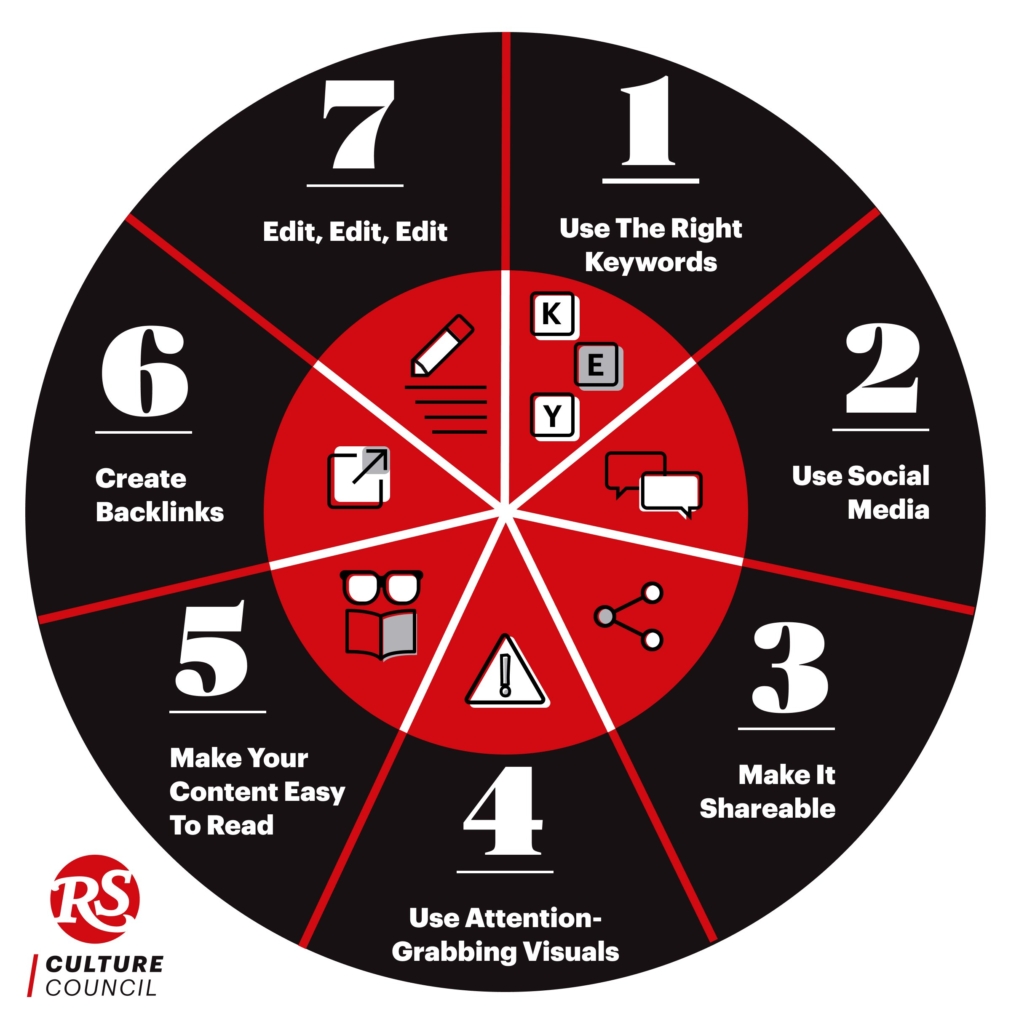
In a world where the Internet and social media platforms reign supreme, it is more important than ever for arts and culture brands to have a strong brand presence online and connect with people in your creative community. One way to achieve this is through strategic content marketing for artists.
Benefits of content marketing
By creating compelling and shareable content, and by sharing with the best social networks for creatives, you can reach a wider audience, increase your visibility, build stronger name recognition, improve your professional network, and attract new customers and clients.
Content marketing can also help you establish thought leadership and position you as the go-to expert in your field.
In order to connect with potential customers, build deeper connections with existing fans, and build long-lasting relationships, a content marketing strategy is essential. It is a powerful tool that can provide your fans new perspectives on your creative work and encourage them to keep coming back for more.
In an age where attention spans are shorter than ever, content marketing provides a way for arts and culture brands to cut through the noise and connect with audiences on a more personal level.
How to express your brand through content marketing
Remember that your content marketing goal is not to sell, but to connect. By creating content that is interesting, helpful, and relevant to your audience, you will be able to build stronger relationships, strengthen your brand recognition and increase your visibility. Here are some ways to express your brand:
- Be human. Write like you speak, and don’t be afraid to show your personality.
- Be helpful. Focus on creating content that is informative and useful.
- Be interesting. Share your unique perspectives and tell stories that will captivate your audience.
- Be visual. Use images, infographics, and videos to break up your text and add visual interest.
- Be responsive. Connect with your audience on different social platforms by responding to comments and questions.
- Be consistent. Keep your branding look and feel consistent across all of your content.
- Be patient. Growing a following takes time so don’t get discouraged if you don’t see results immediately.
- Be authentic. Don’t try to be someone you’re not. Be genuine, and your audience will appreciate it.
- Be creative. Think outside the box and come up with content that will stand out from the rest.
- Be yourself. At the end of the day, the best way to connect with your audience is by being yourself.
- Be relevant. Make sure your content is relevant to your brand and your audience.
- Be engaging. Write headlines that will make people want to click, and keep them engaged with your content until the very end.
- Be strategic. Plan out your content strategy so that you can achieve your goals.
- Be flexible. Don’t be afraid to experiment and be open to change.
- Be persistent. Keep at it, even when it feels like you’re not seeing great results yet.
- Be passionate. Write about something you’re passionate about, and your audience will be able to tell.
- Be timely. Make sure your content reflects what is really going on in the world.
- Have a point of view. Take a stand on something, and don’t be afraid to voice your opinion.
- Be different. Set yourself apart from the rest by thinking outside the box.
Different types of content marketing for different purposes
Not all content is created equal. Here are some of the most popular types of content, and how you can use them to achieve your goals:
- Blog posts. A great way to share your thoughts, opinions, and knowledge with your audience.
- Articles. A more in-depth look at a specific topic. These can be posted on your own blog or as guest-posts elsewhere. Ideally, you’ll do both.
- Case studies. An effective way to showcase your work and demonstrate your expertise.
- eBooks. A helpful resource that can be downloaded and shared with your audience.
- Whitepapers. A more comprehensive look at a particular issue or topic.
- Infographics. A visually appealing way to share information and data with your audience.
- Videos. A great way to connect with your audience on a more personal level.
- Podcasts. A convenient way to share your thoughts and ideas with your audience.
- Webinars. A great way to engage with your audience and provide them with valuable information.
- Slide shares. A helpful way to share your presentations and ideas with your audience.
- Social media posts. A quick and easy way to connect with your audience and share your content every day.
- Images. A great way to add visual interest to your content.
- Memes. A fun and lighthearted way to connect with your audience.
- GIFs. A fun and engaging way to add visual interest to your content.
- Quizzes. A great way to interact with your audience and get them engaged with your content, quizzes assess your audience’s knowledge on a topic. Sending them their results in an email is a great way to get them on your email marketing list.
- Animations. Explainer videos with moving text and images keep the viewer engaged and make it easy to share your message.
- Interactive polls. This gives your audience a chance to feel personally connected to your brand and product/service. People like to compare what they think to what other people think.
Repurposing content for efficiency
You don’t need to start from scratch with every piece of content. That would be a huge task! Repurpose your content to save lots of time.
Typically, that means starting with one longer piece – a video, podcast, or webinar, for example. Get a transcript of that piece, then slice it up into shorter pieces for other types of platforms.
Here are some ideas for how you can repurpose your content:
- Create an infographic from a blog post.
- Turn a video into a blog post or series of social media posts.
- Create a Twitter thread from a longer article.
- Record a podcast episode from a blog post or article.
- Create an Instagram post from a blog post or article.
- Make a Pinterest graphic from an infographic.
- Turn a LinkedIn post into a blog post.
- Create a YouTube video from a webinar.
- Create a Facebook Live video from a blog post.
- Make a GIF from a video or image.
There are endless possibilities. Get creative and think about how you can repurpose your content to reach even more people with less effort and expense.
| Succeed with less effort and more results when you join Rolling Stone Culture Council. Click here to see if you qualify. |
Making the most of your content
In order to “get found” more easily and by more people, there are certain essential strategies:

1 – Create backlinks
Share links from other websites back to your website. They help improve your search engine ranking and make it easier for people to find your site. To create backlinks, you can:
- Guest post on other blogs in your industry.
- Include links to your website in your social media profiles.
- Add links to your website in your email signature.
- Comment on other blog posts and include a link to your website.
- Reach out to influencers in your industry and ask them to mention your website or share your content. Of course it’s best to preface your request of them by sharing their content first and being their advocate.
2 – Use keywords
These are the words and phrases that people use when they’re searching for information online. If you want your content to be easily found, you need to use keywords that people are actually searching for. Use Google Trends to find out what searches are trending for your topic. To find the right keywords, you can:
- Use a keyword research tool like Google Ads Keyword Planner or Moz Keyword Explorer.
- Look at the keywords that your competitors are using.
- Think about the words and phrases that people would use to search for your content.
3 – Once you’ve found the right keywords, be sure to use them in:
- The title of your content
- The headline of your blog post or article
- The description of your video or podcast
- The hashtags of your social media posts
- The text of your blog post or article
- Your website’s meta tags
- Your website’s title and description
- Your website’s URL
4 – Use social media
Social media for artists is a great way to reach more people and promote your content. When you share your content on social media, be sure to:
- Include images or videos. You could even share your work in the right contexts.
- Write a compelling headline.
- Include a call to action.
- Tag other people or brands.
- Use hashtags.
- Cross-promote your content.
- If you have multiple social media accounts, be sure to share your content on all of them. And don’t forget to promote your social media content on your website as well!
5 – Make it easy to share
The easier you make it for people to share your content, the more likely they are to do it. To make it easy to share, you can:
- Include social share buttons on your website or blog.
- Add a “Pin it” button to images on your website.
- Install a social media sharing plugin on your website.
6 – Use attention-grabbing visuals
People are more likely to pay attention to your content and remember it if it includes visuals like images, videos, and infographics.
7 – Make your content skimmable
People rarely read online articles from beginning to end. They tend to skim through them, looking for the information they need. To make your content skimmable, you can:
- Use short paragraphs.
- Use bullet points or numbered lists.
- Use headlines and subheads.
8 – Make your content easy to read
In addition to making your content skimmable, you also want to make it easy to read. That means using short sentences and active voice
9 – Edit, edit, edit
Be sure to proofread your content before you publish it! Typos and grammatical errors will make your content look unprofessional and could turn people away from your site.
=========
When it comes to content marketing for artists and designers, and other arts and culture organizations, there is no one-size-fits-all approach. The most important thing is to find the approach that works for you and your brand, and that resonates most with your audience. Be creative, be authentic, and be strategic, and you will be able to create content that reflects your brand and connects with your audience.
